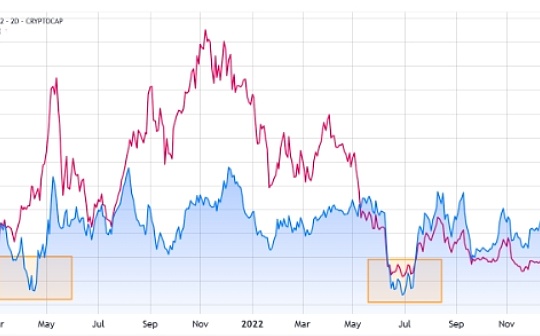April's surprise change: the tested decentralized belief

Reprinted from panewslab
04/25/2025·14DSource: aminagroup
Compilation: BitpushNews Yanan
April 2025 was an uneasy month for the cryptocurrency market. The second quarter seemed calm at the beginning, but many unexpected events soon occurred one after another. All of these events reveal the fragile nature hidden behind the most ambitious projects in the industry. In this article, we will explain the latest on-chain dynamics in detail: from the sudden price plunge to the underlying issues that are more worthy of attention - the practical status of the decentralized concept, the effectiveness of risk management, and the real way of protocol governance.

Mantra's unexpected crash
On April 13, 2025, Mantra, the benchmark project in the real-world asset tokenization, suffered a dramatic price plunge. Its token $OM fell sharply from $6 to $0.6 in just a few minutes, with a staggering 90% drop that instantly evaporated the $5.5 billion market value. This collapse not only hit market sentiment hard, but also exposed deep problems in project operations, and even made the feasibility of the entire RWA (real world asset) track questioned.
As a pioneer in introducing traditional assets such as real estate and bonds into blockchain, Mantra has won the favor of institutions and retail investors at the same time, and its development momentum seems unstoppable. However, under the glamorous appearance, hidden dangers have long been laid - the most critical contradiction is concentrated on the token allocation mechanism of $OM.
The project initially promised to issue 50 million tokens and adopt a phased unlocking solution, but it quietly adjusted to release 0.3% daily without sufficient communication and lasted until the ultra-long vesting period in 2027. Although the team claimed that this was to maintain long-term stability, community members generally felt kept in the dark: they were not able to participate in key decisions, but were increasingly confused about the actual direction of the project.
The fuse of the collapse is ignited in Binance futures market. Within a few seconds, a series of large-scale short orders emerged one after another, forming huge selling pressure on the $OM price. Liquidity on other platforms such as Bybit and OKX began to dry up almost at the same time - among them, the last trader of OKX, who was later called "OM Whale", further pushed down prices through continuous large-scale sell orders, completely igniting market panic.
On-chain data reveals even more disturbing signs. A giant whale wallet that had held coins for more than a year suddenly began to transfer a large amount of $OM tokens to the exchange. Although a single transfer is not surprising, the timing formed a terrible resonance with the exchange's sell-off, accelerating the market's out of control.
In the end, nearly 4 million $OM were sold in a short period of time, triggering chain liquidation and completely defeating the market's last line of confidence. This seemingly organized sell-off soon turned into a full-scale collapse, causing the community's trust in the project to collapse.
The collapse of Mantra taught the industry a heavy lesson: rebuilding a new order on the traditional financial system requires a more rigorous architecture than imagined. Although the prospects for real asset tokenization are still broad, this incident clearly shows that projects must have true transparency, fairness, and resilience to resist extreme market volatility. Without these foundations, even the best vision may turn into a bubble in an instant.
ArbitrumDAO's governance storm
A recent farce staged at Arbitrum DAO has exposed the weaknesses of decentralized governance. A user named hitmonlee.eth obtained a $6.5 million voting right to use the Lobby Finance platform for only 5ETH (about $10,000). This platform specializing in voting rights delegation has inadvertently opened a convenient door for the governance of loopholes.
After holding huge voting rights, the user immediately supported community member CupOJoseph to run for the DAO Supervisory and Transparency Committee seat. Although the exchange of interests in governance games is not uncommon, the particularity of this incident is that such a large-scale voting right can be bought at such a low price. This discovery immediately caused an uproar in the community, and forced people to re-examine the real value of the so-called "decentralization" on the chain.
Faced with doubts, Lobby Finance defended its model, highlighting the platform’s aim to promote transparency and widespread participation in governance. However, the platform also admitted that the existing mechanism has flaws and admitted that stricter protective measures may be needed to prevent potential abuse. This statement caused greater turmoil in the community - the debate on the direction of governance reform continues to ferment: some members advocated direct ban on obtaining voting rights through fund transactions; others proposed to establish a "safe channel" mechanism, requiring funds to be transferred through credible channels so that they can intervene in a timely manner when violations are found.
Nowadays, decision-making power falls completely in the hands of the community. The Arbitrum Foundation has made it clear that it will not interfere with voting transactions administratively, but will leave it to the community to decide on its future direction independently: Should funds be allowed to purchase voting rights? How to punish obvious manipulation? Or should this kind of transaction be regarded as an inevitable market behavior in decentralized governance?
This debate directly points to a more essential problem: the inherent flaws of the "one coin, one vote" governance model. This incident exposed these structural weaknesses. To truly solve the problem, what is needed is not superficial adjustment, but a fundamental reconstruction of the power distribution and decision-making mechanism in the Arbitrum ecosystem.
Hyperliquid's crisis moment
Hyperliquid has encountered frequent security crises since its launch, and the events that happened a few weeks ago almost put this derivatives trading platform in a desperate situation.
In January this year, a giant whale established a leveraged position of up to $300 million on ETH. When the trader withdraws $8 million without realizing profits, the liquidation threshold is quietly pushed up. When the market reversed, Hyperliquid's insurance pool—which consists of funds deposited by users into the HLP vault—was forced to take over the position and ended up losing about $4 million. This incident exposed serious flaws in platform risk management, but few people realized at the time that this was just the beginning of the crisis.
The real storm came on March 26, and a game surrounding the unpopular meme token JELLY almost destroyed the entire protocol. This carefully designed attack is textbook-level:
1. The attacker deposited $3.5 million USD and shorted JELLY with a market value of only $10 million on Hyperliquid, hitting the platform leverage ceiling
2. Another giant whale holding 126 million JELLY sold in the spot market simultaneously, causing a price to plummet
3. The attacker quickly withdrew most of the deposit and created insufficient mortgage
4. Hyperliquid's automatic liquidation system is forced to let HLP vault swallow 398 million JELLY short positions
5. The attacker then repurchased JELLY on CEX, driving the price to soar by 300%.
Hyperliquid faces unrealized losses of more than $10.5 million when JELLY prices soar. What’s even more terrifying is that if the price hits $0.16, the potential loss may expand to $240 million.
Just when Hyperliquid was in crisis, mainstream exchanges such as Binance and OKX suddenly launched JELLY perpetual contracts, unexpectedly adding a dramatic twist to the farce. This move was interpreted by some observers as intentionally pushing up prices and weakening Hyperliquid's market position. But the real turning point came 26 minutes ago – the Hyperliquid Verifiers Committee has voted to remove JELLY. In the end, JELLY price magically returned to the starting point of short selling, and the HLP vault not only avoided catastrophic losses, but instead obtained $700,000.
This thrilling escape cost Hyperliquid: to preserve the agreement, its proud decentralized architecture was temporarily shelved, revealing that the centralized mechanism is still turning the tide when it is crisis-time.
The incident reveals a cruel reality: Hyperliquid must thoroughly reinforce its system. Although the upgrade is expensive - it requires the use of the agreement vault funds, this investment is imperative to build long-term resilience. Currently, the platform activity indicators show that it is working in this direction, but any system is difficult to say perfect. Attackers always wait for opportunities to find vulnerabilities, as this JELLY incident proves.
Although the decision to remove JELLY in time avoids greater losses (even achieves net gains), its decision-making process—quickly executed by a few validators and adopts non-market price settlement—has once again raised questions about the degree of decentralization of the platform.
Hyperliquid may have temporarily overcome the crisis and even has a slight surplus on the books. But if the loopholes cannot be fundamentally patched and operational transparency is enhanced, this platform may overdraft support its valuable trust that has developed to this day. The real test has just begun.
Reflection and enlightenment
The market turmoil over the past few weeks has ruthlessly revealed the huge gap between the beautiful vision and the reality of landing in the cryptocurrency field. These events send a clear signal: strict risk control, transparent decision-making mechanisms and stable liquidity management are not icing on the cake, but the foundation for project survival.
For projects like Hyperliquid and Arbitrum, patching vulnerabilities is much more than technical code updates. The real challenge is: How to rebuild community trust? How to maintain transparency in governance? And how to show the responsibility and ability to cope in times of crisis?
The collapse of Mantra is a wake-up call for all projects that serve institutions - in this field, perfect risk management and stable operational capabilities are not bonus points, but admission tickets. Nowadays, what is facing the industry is an unavoidable choice: should we deeply learn from these lessons obtained with real money, or continue to dance on the tip of the knife and welcome a more violent storm?



 jinse
jinse